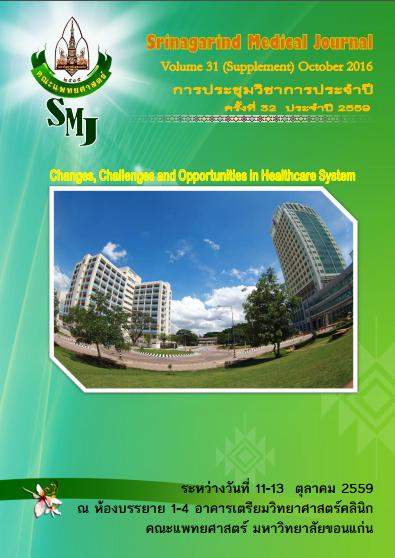Normal Multifocal Electroretinograms Study in Srinagarind Hospital: A pilot Study
Keywords:
multifocal Electroretinograms, RETI scanAbstract
Background and objective:Multifocal electroretinograms (mfERG) measures and records electrical activity of macula. Currently,VERIS system isused more worldwide than RETIscan system. mfERG used in Srinagarind hospital is RETIscansystem,but normal values innortheastern populationhaveneverbeen studied before. The authors aim to study baseline database of northeastern population.
Method: 30 of 120 normal subjects(240 eyes) were categorized intoeach age groups; 10-20, 21-40, 41-60 and >60years-old.Complete ocular examination and mfERG were performed.
Results: 38 subjects were male and82subjectswere female. Mean age were 18.1±2.2, 29.9±4.3, 50.4±4.3and 64.3±3.8 years-old.Best corrected visual acuity of 110 subjects were 6/6, significant lens opacity was detected in 10 subjects. Refractive error was demonstrated between -3.25 to+3.50 PD.Average latency and amplitude of N1were20.92±0.55ms. and 34.42±3.03 nV/deg2. Average latency and amplitude of P1 were39.48±0.5 ms.and 79.89±3.13 nV/deg2. Latency and amplitude of N1and P1 were similar in each quadrantsin all groups. Theresults of this study were comparable tothe standard value of RETIscansystem. Although amplitude of P1 in the oldest groups was lower than normal value of RETIscanafter subgroup analysis, it was not statistically significant.
Conclusion: Many factors can interfere mfERGrecording such as ethnicity, aging and cataract. The normal value of mfERG should be studied for baseline database in each institute. However, this was a pilot study. Further research is needed to gain more information.




